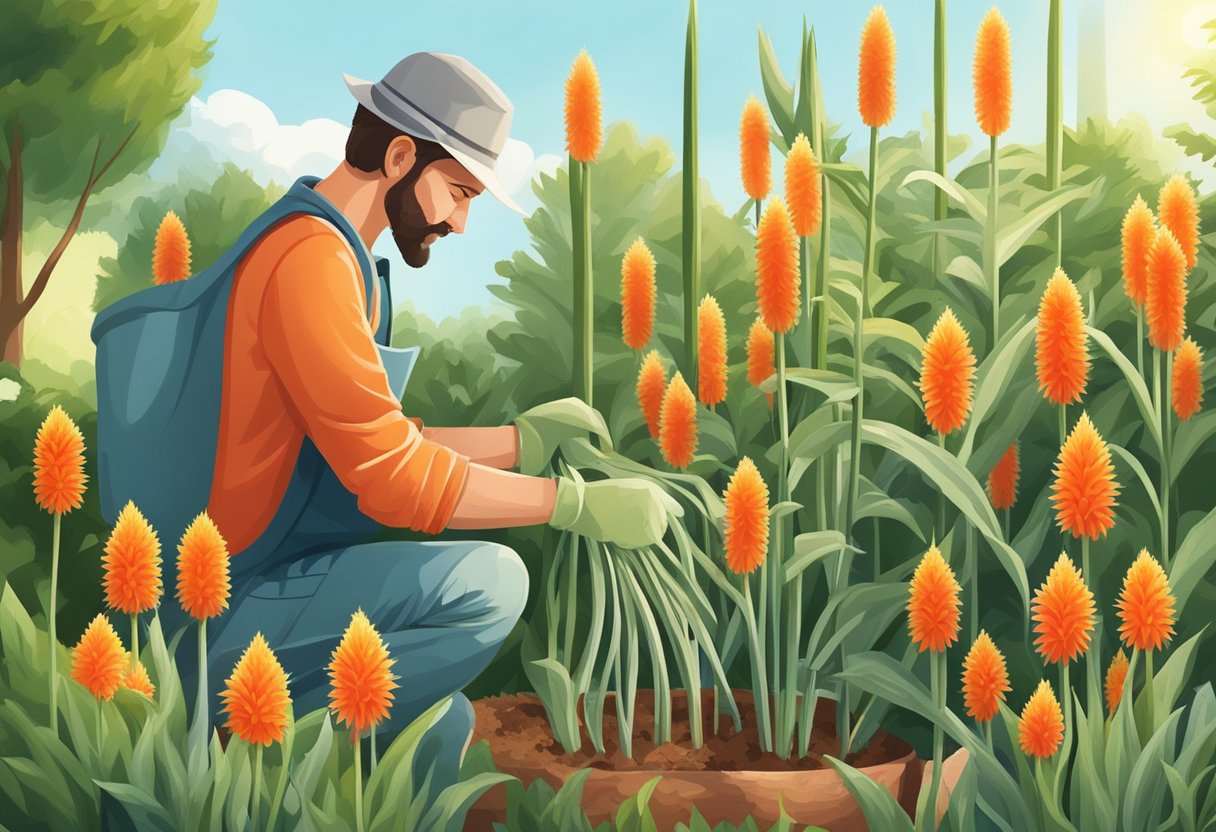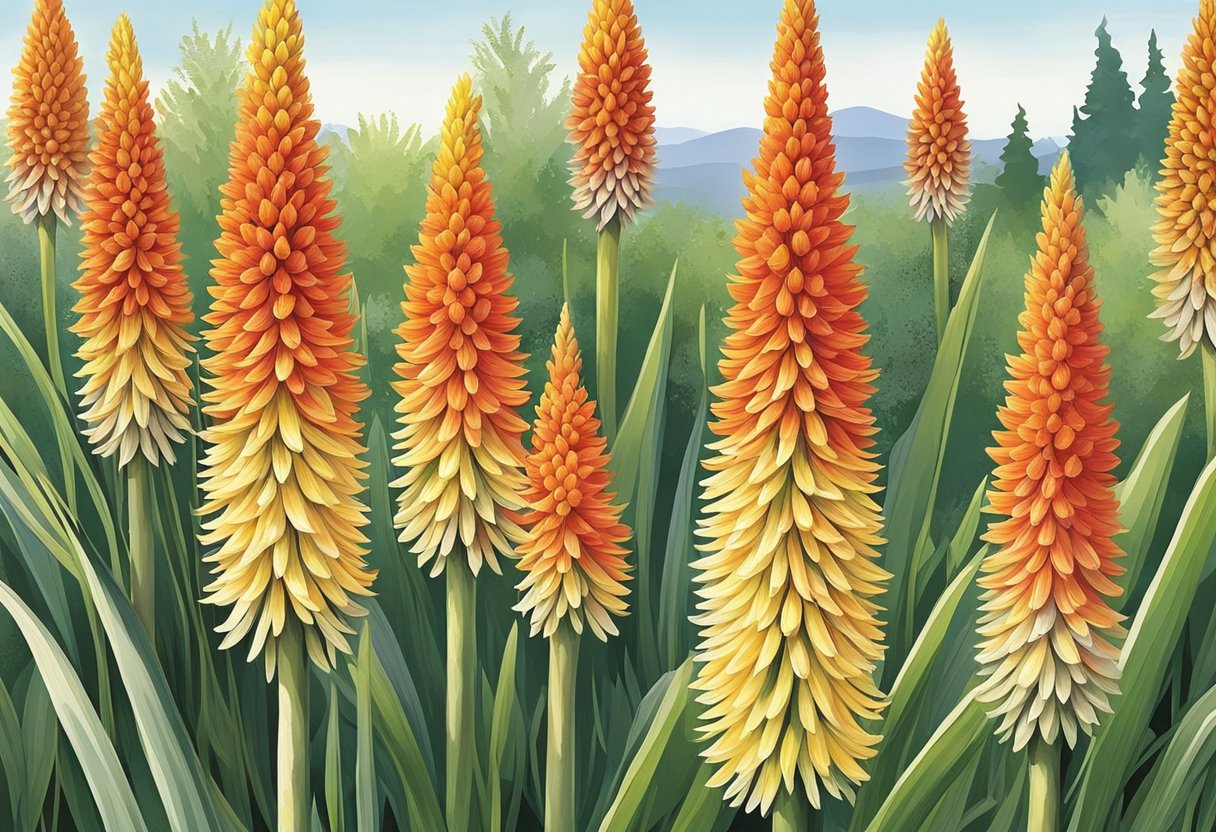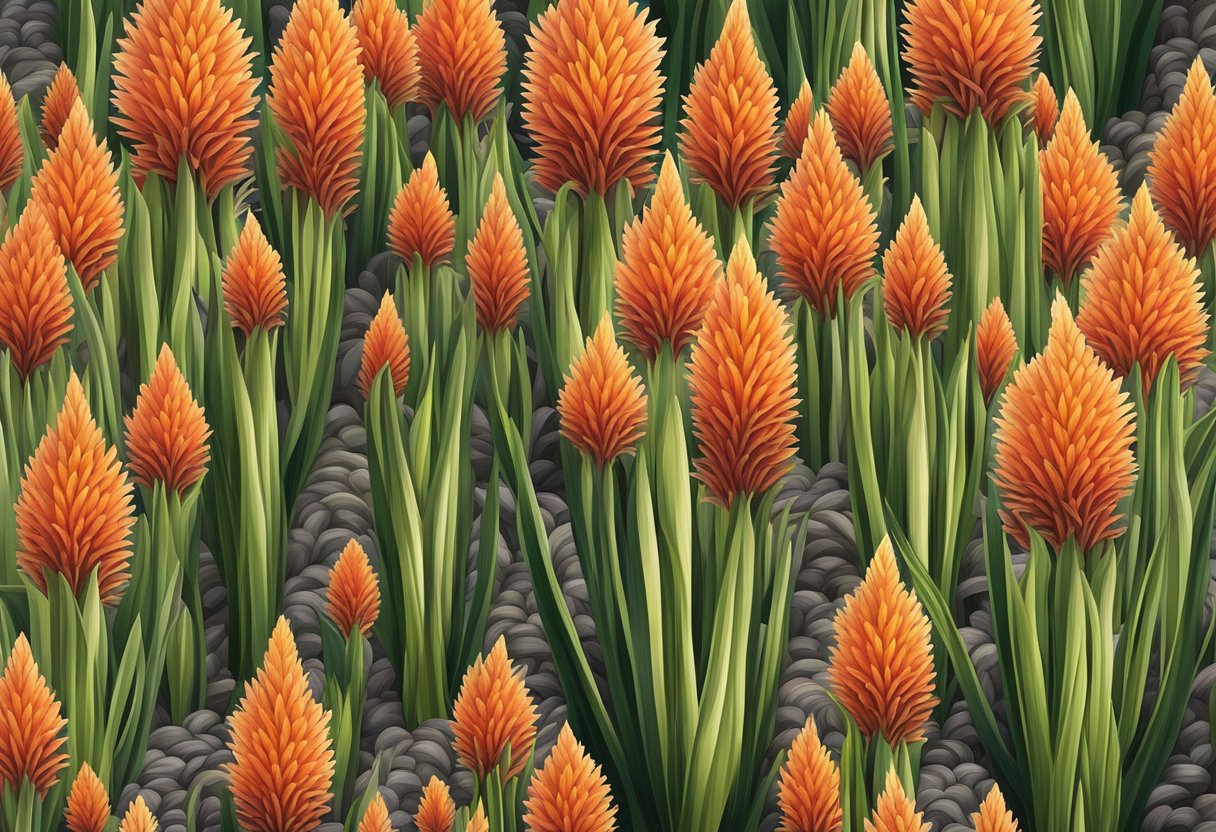Caring for Red Hot Poker Plant: Tips and Guidelines
Red hot poker plants, also known as Kniphofia, Torch Lily, African Flame Flower, or Asphodelaceae, are a popular choice for gardeners who are looking for a plant that is both visually striking and easy to care for. With their tall spikes of brightly colored flowers, these plants are sure to add a touch of drama to any garden or landscape. However, like all plants, red hot poker plants require some basic care in order to thrive.

One of the most important things to keep in mind when caring for red hot poker plants is that they require well-draining soil. These plants are native to South Africa, where they grow in rocky, arid conditions. As a result, they are not well-suited to heavy, clay soils. Gardeners should ensure that the soil in which they plant their red hot poker plants is loose and well-draining, with plenty of organic matter to help retain moisture.
Another key aspect of caring for red hot poker plants is providing them with adequate sunlight. These plants require full sun in order to thrive, and will not do well in shady or partially shaded areas. Gardeners should choose a planting location that receives at least six hours of direct sunlight per day, and should avoid planting their red hot poker plants in areas that are prone to waterlogging or standing water. With these basic care requirements in mind, gardeners can enjoy the beauty and drama of red hot poker plants in their gardens for years to come.
Plant Overview

Species and Cultivars
The red hot poker plant, also known as torch lilies or Kniphofia uvaria, is a perennial herbaceous plant native to South Africa. There are over 70 species of Kniphofia, with varying colors and sizes of flowers. Many cultivars have been developed, including ‘Flamenco’, ‘Alcazar’, and ‘Percy’s Pride’.
Plant Characteristics
The red hot poker plant has long, narrow leaves that grow in a clump and can reach up to 3 feet in height. The flowers are arranged in dense spikes that can grow up to 4 feet tall, with colors ranging from red, orange, yellow, and green. The flowers bloom from late spring to early fall, attracting hummingbirds and butterflies.
This plant prefers full sun and well-draining soil, and can tolerate drought once established. It is hardy in USDA zones 5-9 and can be grown in containers or in the ground. The plant can be propagated by division in the spring or fall.
Overall, the red hot poker plant is a beautiful and low-maintenance addition to any garden. Its striking flowers and unique foliage make it a standout among perennials.
Site Selection and Planting
Soil Requirements
Red hot poker plants prefer well-draining soil that is rich in organic matter. They do not tolerate wet or waterlogged soil, which can cause root rot. If your soil is heavy or clay-like, consider amending it with compost or sand to improve drainage.
Sunlight and Temperature
Red hot poker plants thrive in full sun and require at least six hours of direct sunlight per day. They can tolerate some shade, but too much shade can result in leggy growth and fewer blooms. These plants are hardy in USDA zones 5-9 and can tolerate a wide range of temperatures. However, they may benefit from some protection in extreme heat or cold.
When planting red hot poker plants, choose a location that receives full sun and has well-draining soil. Dig a hole that is twice as wide and deep as the plant’s root ball. Gently loosen the roots and place the plant in the hole, making sure the top of the root ball is level with the soil surface. Backfill the hole with soil and water thoroughly.
Overall, red hot poker plants are relatively easy to grow and care for, as long as their basic needs for sunlight, well-draining soil, and appropriate temperature are met. With proper site selection and planting, these plants can provide a striking accent to any garden or landscape.
Plant Care and Maintenance
Red hot poker plants are relatively low maintenance and easy to care for. However, there are a few things you can do to ensure that your plant thrives.
Watering and Moisture
Red hot poker plants prefer well-draining soil and do not like to be waterlogged. It is best to water them deeply but infrequently, allowing the soil to dry out between waterings. In hot, dry weather, you may need to water more frequently. Be sure to water at the base of the plant to avoid getting water on the leaves, which can cause leaf spot.
Fertilizing and Nutrients
Red hot poker plants do not require a lot of fertilizer, but a balanced, slow-release fertilizer can help promote healthy growth and flowering. Apply fertilizer in the spring and again in midsummer. Be sure to follow the manufacturer’s instructions for application rates.
Pruning and Deadheading
Red hot poker plants do not require much pruning, but you can remove spent flower spikes to encourage the plant to produce more blooms. Deadheading can also help prevent the plant from self-seeding and becoming invasive. Cut back the entire plant to the ground in late fall or early spring to promote new growth.
Overall, red hot poker plants are easy to care for and can provide a stunning display of color in your garden. With proper watering, fertilizing, and pruning, you can enjoy these beautiful plants for years to come.
Propagation and Division

Red hot poker plants can be propagated through seed or division of rhizomes. Both methods are fairly simple and can be done in the spring or fall.
Seed Propagation
To propagate red hot poker plants from seed, start by collecting seeds from mature plants in the fall. Store the seeds in a cool, dry place until the following spring.
In the spring, sow the seeds in a seed tray filled with a well-draining potting mix. Cover the seeds lightly with soil and water thoroughly. Keep the soil moist and warm, ideally between 70-75°F.
Germination should occur within 2-3 weeks. Once the seedlings are 2-3 inches tall, transplant them into individual pots. Continue to care for the seedlings until they are large enough to be transplanted outdoors.
Dividing Rhizomes
Red hot poker plants can also be propagated through division of rhizomes. This method is best done in the spring or fall.
To divide the rhizomes, start by digging up the plant and gently separating the rhizomes. Each section should have a few healthy roots and at least one growing point.
Replant the divided rhizomes in a well-draining soil mix, with the growing point just below the soil surface. Water thoroughly and keep the soil moist until the plant becomes established.
Propagation through division of rhizomes is a great way to maintain the health and vigor of your red hot poker plants.
Seasonal Considerations

Spring Care
Red hot poker plants are easy to care for, but they do require some attention in the spring. After the winter months, it is important to cut back any dead foliage and remove any mulch that was used to protect the plant during the colder months. This will allow new growth to emerge unobstructed.
In addition, it is recommended to fertilize the plant with a balanced fertilizer in early spring. This will help encourage healthy growth and vibrant blooms later in the season.
Fall Preparation
As the growing season comes to a close, it is important to prepare the red hot poker plant for winter. This can be done by cutting back any dead foliage and removing any spent blooms. It is also a good idea to add a layer of mulch around the base of the plant to help protect it from the cold.
Winter Protection
Red hot poker plants are generally hardy and can withstand cold temperatures, but it is still important to provide some protection during the winter months. This can be done by adding a layer of mulch around the base of the plant to help insulate the roots. It is also recommended to cover the plant with a frost cloth or burlap if temperatures are expected to drop below freezing.
Overall, with a little bit of attention and care, red hot poker plants can thrive in any season. By following these simple seasonal considerations, gardeners can enjoy beautiful blooms year after year.
Pest and Disease Management

Common Pests
Red hot poker plants are generally pest-resistant, but they can still fall victim to a few common pests. Aphids are the most common pests that attack these plants. They suck the sap from the leaves and cause them to curl and yellow. To control aphids, one can use insecticidal soap or neem oil. Another pest that can attack red hot poker plants is the thrips. They damage the flowers and leaves, causing them to become distorted and discolored. To control thrips, one can use insecticidal soap or neem oil.
Disease Prevention
Red hot poker plants are generally disease-resistant, but they can still fall victim to a few diseases. Root rot is a fungal disease that can be caused by overwatering or poorly drained soil. To prevent root rot, one should ensure that the soil is well-drained and the plant is not overwatered. Slugs and snails can also attack red hot poker plants, causing damage to the leaves. To prevent slugs and snails from attacking the plants, one can use slug and snail bait or copper tape around the base of the plant.
Overall, red hot poker plants are relatively easy to care for and maintain. By following these simple pest and disease management tips, one can ensure that their plants remain healthy and vibrant.
Landscape and Garden Uses

Garden Design
Red hot poker plant is a versatile plant that can add a pop of color to any garden design. It is commonly used in mixed borders and cottage gardens, where its upright growth habit and striking blooms create a focal point. The plant’s height can range from 2 to 4 feet, making it an ideal choice for adding vertical interest to garden beds.
For a bold statement, gardeners can plant red hot poker in mass groupings. This creates a stunning display of fiery red and orange blooms that can be seen from a distance. The plant’s spread is also an important consideration when designing a garden. Red hot poker can spread up to 3 feet, so it is important to give it enough space to grow and avoid overcrowding.
Container Gardening
Red hot poker plant is also an excellent choice for container gardening. Its upright growth habit and compact size make it a great choice for pots and containers on patios and balconies. When planting in containers, it is important to choose a well-draining soil mix and ensure that the container has adequate drainage holes.
Gardeners can also mix red hot poker with other plants in container gardens to create a stunning display of color and texture. The plant’s height and spread should be considered when selecting companion plants to ensure that they complement each other.
Overall, red hot poker plant is a versatile and striking plant that can add a pop of color to any garden or container. Its upright growth habit, height, and spread make it an ideal choice for gardeners looking to add vertical interest and bold color to their landscape.
Wildlife Attraction

Red hot poker plants are known for their striking appearance and ability to attract wildlife to the garden. In this section, we will explore the different types of wildlife that are attracted to the red hot poker plant and how they contribute to the ecosystem.
Pollinators and Birds
Red hot poker plants are a great source of nectar for pollinators such as bees, butterflies, and hummingbirds. The tall spikes of the plant provide an easy landing spot for these insects and birds to access the nectar. The bright red and orange flowers are particularly attractive to hummingbirds, who are known to hover around the plant for extended periods of time.
Birds are also attracted to the red hot poker plant for other reasons. The tall spikes of the plant provide a great vantage point for birds to perch and observe their surroundings. The plant also produces seeds that are a source of food for birds such as finches and sparrows.
Red hot poker plants are also known for being deer resistant, which is an added benefit for gardeners who live in areas with high deer populations. Deer are unlikely to eat the plant, which means that it can thrive in areas where other plants may struggle.
Overall, the red hot poker plant is a great addition to any garden looking to attract wildlife. Its bright colors and tall spikes make it a favorite among pollinators and birds, while its deer resistance makes it a practical choice for gardeners looking to protect their plants.
Varieties and Companions

Popular Varieties
Red hot poker plants come in a variety of cultivars with different flower colors and bloom times. Some popular varieties include:
- ‘Royal Standard’: This cultivar has a red and yellow flower spike that blooms in mid-summer and grows up to 3 feet tall.
- ‘Pineapple Popsicle’: This cultivar has orange and yellow flowers that bloom in mid-summer and grows up to 2 feet tall.
- ‘Flamenco’: This cultivar has red and yellow flowers that bloom in early summer and grows up to 4 feet tall.
Companion Plants
When choosing companion plants for red hot poker plants, it is important to consider plants with similar growing conditions and complementary colors. Some good options include:
- Yarrow: This plant has fern-like foliage and blooms in a variety of colors, including white, pink, and yellow. It is drought-tolerant and prefers full sun, making it a great companion for red hot poker plants.
- Dahlia: This plant has large, showy blooms in a variety of colors, including red, orange, and yellow. It prefers full sun and well-draining soil, making it a good companion for red hot poker plants.
- Coneflower: This plant has daisy-like flowers in a variety of colors, including red, orange, and yellow. It prefers full sun and well-draining soil, making it a good companion for red hot poker plants.
Overall, red hot poker plants are easy to care for and make a great addition to any garden. With the right companion plants, they can create a stunning display of color and texture.
Frequently Asked Questions
How should I overwinter my red hot poker plants?
Red hot poker plants are hardy to USDA zones 5-9 and can survive mild winter temperatures. If you live in an area with harsh winters, it’s best to overwinter your red hot poker plants indoors. To do this, dig up the plants before the first frost and store them in a cool, dry place such as a garage or basement. Cut back the foliage and water the plants sparingly throughout the winter.
What are the best practices for growing red hot poker plants in containers?
Red hot poker plants can be grown in containers, but it’s important to choose a pot that is at least 12 inches in diameter and has drainage holes. Use a well-draining potting mix and water the plant regularly, making sure the soil doesn’t dry out completely. Fertilize the plant every two weeks during the growing season with a balanced fertilizer.
Why isn’t my red hot poker plant flowering, and how can I encourage blooms?
Red hot poker plants need full sun and well-draining soil to bloom. If your plant isn’t flowering, it may be receiving too much shade or the soil may be too moist. Try moving the plant to a sunnier location and make sure the soil is well-draining. You can also encourage blooms by fertilizing the plant with a high-phosphorus fertilizer.
Is it necessary to prune red hot poker plants, and if so, when?
Red hot poker plants don’t require regular pruning, but you can remove dead or damaged leaves throughout the growing season. In the fall, cut back the foliage to about 6 inches above the soil line.
What are the ideal growing conditions for red hot poker plants?
Red hot poker plants prefer full sun and well-draining soil. They can tolerate some drought, but it’s important to water the plant regularly during dry spells. Fertilize the plant every two weeks during the growing season with a balanced fertilizer.
Are red hot poker plants considered toxic to humans or pets?
Red hot poker plants are not considered toxic to humans or pets. However, the plant can cause skin irritation in some people, so it’s important to wear gloves when handling the plant.


